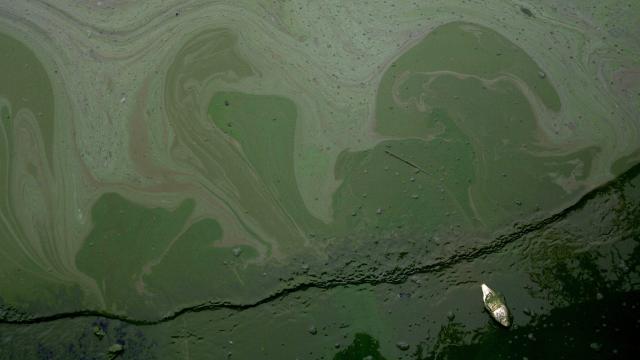A pair of tragic stories reported this past weekend in America are raising awareness of a threat to both people and animals in the water: algae. At least four dogs in two U.S. states along the southeast coast have reportedly died from swimming in freshwater lakes and ponds filled with toxic blue-green algae. And as the climate warms, these sad cases could become more common in the U.S. and elsewhere.
In a Facebook post published early last Friday, North Carolina resident Melissa Martin said she and her friend Denise Mintz had taken their three dogs — Abby, Izzy, and Harpo — for a Thursday night swim at a local pond. But within minutes of leaving, Abby began suffering a seizure. And though all three were quickly taken to a veterinary hospital, none survived. According to her veterinarian, Martin wrote, they had died from algae poisoning.
The same basic story would soon repeat itself in Georgia. In a Facebook post published Saturday, Morgan Fleming recounted how her dog Arya had playfully swam in their local lake all day, only to start throwing up and being unable to stand soon after they left. By the time Arya was taken to the ER, she had lost consciousness. She died soon after. Fleming, like Martin, blamed the death on blue-green algae.
At this point, the cause of death for all four dogs remains unconfirmed, pending a possible autopsy or investigation of the water sources. But these wouldn’t be the first deaths linked to algal swarms.
Blue-green algae is something of a misnomer. Most things we consider algae are plants or very closely related to plants, like species of seaweed. But it’s microscopic critters called Cyanobacteria that make up blue-green algae. Like plants, though, Cyanobacteria do use the Sun to nourish themselves.
In small quantities, algae typically isn’t harmful to wildlife or humans. But when the feeding conditions are right, they can quickly grow into giant blooms. It’s these algae blooms — characterised by the vivid, viscous discolourations of water they create — that can spew enough toxins into the water to seriously harm or kill animals unlucky to come across them.
Dogs might be more susceptible to algae poisoning, given their smaller bodies, but humans are at risk, too.
A 2014 study from the U.S. Centres for Disease Control and Prevention found there had been at least 11 outbreaks of illnesses caused by algae in the U.S. between 2009 and 2010, which collectively sickened 61 people and left two hospitalised.
All of these outbreaks were traced to freshwater. Most were clearly linked to blue-green algae, and some happened alongside a wave of nearby animal deaths, including dogs. A study by New York health officials in 2017, also periodically plague Florida’s coasts.
More recent U.S. data on how often these blooms are hurting people and animals is limited (a national, voluntary surveillance system was rebooted by the CDC in 2016). But the CDC has declared algae blooms an emerging public health issue. And though the effects of climate change on algae populations and other disease-causing things like ticks are complex, it’s likely that warmer temperatures have contributed to a growing increase and potency of algae blooms in recent years.
That’s especially true for blue-green algae, since it thrives in warm freshwater. Even the U.S. Environmental Protection Agency, which has been reluctant to discuss climate impacts under the Trump administration, still says as much for the time being.
Some states do have their own surveillance programs for algae, including North Carolina, but Martin said she didn’t see any warnings for the pond she and her unlucky dogs visited.
In honour of their loved canines, Martin and others have started an already successful GoFundMe that they say will raise funds to post signs in front of any water sources that could be contaminated with algae.
“I will not stop until I make positive change,” Martin told CNN. “I will not lose my dogs for nothing.”
